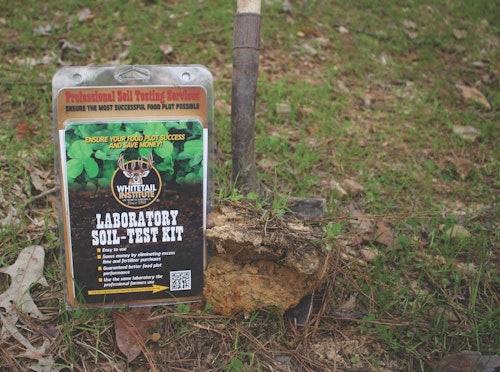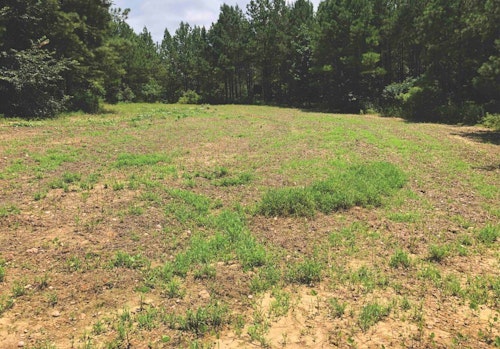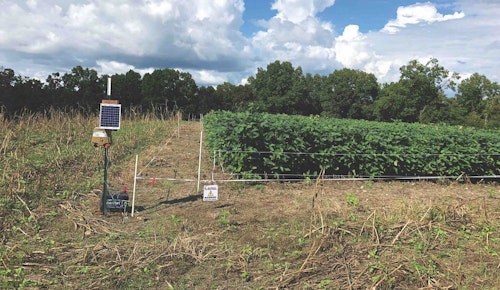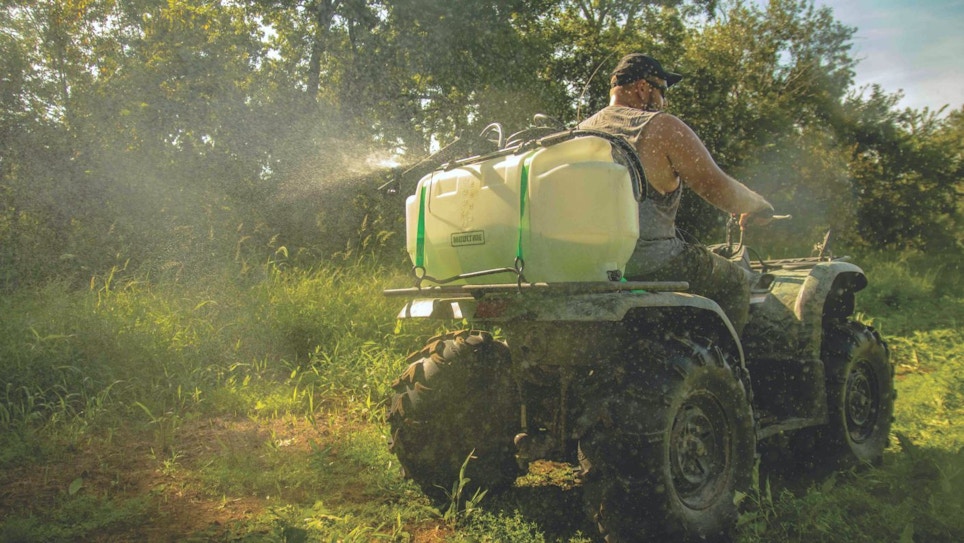When I was new to food plotting, and wildlife management in general, I was content with planting beautiful and attractive fall food plots. My thinking was twofold: 1) create palatable and attractive food plots to hunt over, and 2) provide food to deer during the stressful winter months. However, I thought that once the spring green up happened, the deer would be good to go until next winter. I was right about the spring green up phase, there is plenty of high-protein, palatable food available for deer to browse on. However, as summer sets in, many plants become too fibrous, less palatable and less nutritious. Then you add in hot, dry weather in late summer and this period can be as stressful — nutritionally speaking — as harsh winter conditions. During this time of the year, does are raising and nursing fawns and bucks are vigorously growing antlers.
Once I realized that forage high in protein was necessary for pregnant and lactating does and for optimal antler development in bucks, I became interested in summer plots. There are a number of summer crops to choose from too. Soybeans are king of summertime nutrition. Many land and wildlife managers plant soybeans specifically for deer because they contain 25 to 30 percent protein in the leaves. Biologists recommend that bucks receive at least 16 percent protein in their food during the summer for optimal antler growth — the same for does with fawns.
Other high-protein plants include lablab and cowpeas as well as other varieties of legumes. Both of these plants are similar to soybeans in look and production, and deer love them. While corn does all of its growing during the summer, I don’t count it as a quality forage crop because it doesn’t provide food until early fall through winter. This does the deer herd no good in the summer. For the sake of this article, we’re specifically referring to summer crops that will provide high-protein forage to deer during the summer growing season.

So, if summer plots are so valuable to the deer herd, then why doesn’t everyone do it? For starters, not everyone is interested in managing the deer herd. Many hunters enjoy heading to the woods to hunt deer — and that’s the end. There is nothing wrong with this philosophy either. It wasn’t too many years ago that all deer hunters fell into this category. However, over the past 30 years, food plots and wildlife management have grown by leaps and bounds. Today, there is more science and information available to a dedicated individual or group who can manage their property in order to maximize the antler and hunting potential on their land.
If you fall into this category, then summer food plots are the next step in bettering your local deer population. However, let me be up front, there are some major pitfalls a land manger can fall into if he doesn’t take the proper precautions when it comes to planting summer food plots. Here are the top five issues that can derail your summer plots and leave you more frustrated than before you began. Fortunately, I’ll share the remedies that I’ve learned over the years to fix these problems.

1. Skipping the Soil Test
A soil test is the best $10 to $15 you can spend on a food plot. A soil test is going to tell you exactly what your soil is lacking in nutrients and tell you how to correct it. Crops like soybeans need nitrogen (N), potassium (P) and phosphorous (K) to compete with browsing pressure and to transfer the high-quality nutrients to the deer feeding on them. A laboratory soil test will tell you exactly what your soil is missing and how much you’ll need per acre to correct it. A soil test will also tell you what your soil’s pH is. This is extremely important. Many soils are acidic, meaning they have a pH below 7.0, which is neutral. Most crops prefer a neutral pH for optimum growth. If your soil is acidic, the soil analysis will recommend the amount of agricultural lime needed to correct it.
2. The Wrong Size Plot
When planting soybeans, size really does matter. I’m talking size of the food plot. Soybeans are so attractive to deer, that they will begin feeding on them as soon as they sprout. This isn’t necessarily good for your crop as agricultural varieties cannot handle the browse pressure at this early stage and will die out. There is nothing worse than spending the time and money on soybeans only to come back to a dead or weed-choked plot because the deer have literally hammered your crop.
This is where a forage variety of soybean such as the one from Eagle Seed can help. These beans are developed to handle heavy browse pressure while continuing to grow new stem and leaf growth, which is loaded with protein. If your main goal is to provide high-protein forage during the summer months, then you’ll want to ask your local seed distributor for a quality forage variety that will do well in your climate. Land managers that want to produce bean pods for the deer to feed on in the winter months need to choose a shatter-resistant variety over a forage bean.
Even forage soybeans can be overgrazed if in too small of a plot with a large deer population. In an area with a high deer density, don’t even attempt a summer soybean plot unless you have a 5-acre or larger field to dedicate to soybean production. If your goal is to produce many pods for wintertime feeding, then you might want to plant a field larger than 5 acres. If your deer populations aren’t as dense, then you might be able to get by with planting a forage soybean in a 2-acres or larger plot. Just don’t expect to plant soybeans in a .25-acre plot to accomplish your summer nutritional goals. Chances are you’ll have nothing but nipped-off stems and lots of weed competition.

3. Out-of-Control Weeds
If you plan to take the plunge into summer food plots, then you’ve also signed up to deal with weeds. Weeds can literally make you lose sleep at night when managing your summer plots. However, this typically happens when the land manager doesn’t stay on top of an herbicide schedule or follow other agricultural practices to combat this issue.
Food plotters have never had it so good when it comes to ways to combat weeds in summer plots. From Roundup Ready soybeans, a.k.a. glyphosate-resistant beans, to highly effective herbicides and detailed spray schedules, a land manager can definitely keep a high-quality forage crop producing. For one, you’ll need a quality sprayer. This can be a large tractor-pulled sprayer or an ATV model. A tractor-operated sprayer is going to be ideal for treating many acres of summer plots. Whereas an ATV-style sprayer works great for 5 to 10 acres of summer plots. Regardless of what you use, always spray when weeds are young and newly emerging and when plants are growing well. Mature plants are much harder to kill and plants in distress from a drought won’t take up the herbicide well enough to kill the plant.
Grass competition is typically going to be an issue with summer plots. Once you disc ground, spread or drill seed and cover it, you’ve greatly disturbed the soil and seed bank in it. This will always result in a flush of vigorously growing grass weeds. Without treatment, grass competition will eventually take over your plot or leave it looking pitiful. If you go for a Roundup Ready variety of plant, then you simply spray Roundup or a generic version with glyphosate. Glyphosate is a non-specific weed killer, which means it will kill grass and broadleaf weeds. However, Roundup Ready crops have been genetically modified to withstand glyphosate and continue growing. The result is a nearly weed-free plot with a beautiful crop growing in it.
There is one downside to the Roundup Ready option, and it’s called pigweed. This broadleaf weed has become glyphosate resistant in many areas of the country and has proven hard to kill once it does. Once this weed becomes established in your plot, you’ll have to resort to planting different crops to utilize different herbicides or begin using a pre-emergent herbicide that will control pigweed before it sprouts. This weed can be a nightmare to control, but you can control it by following the proper herbicide/field preparation. It’s best to talk to your local co-op, farmer or food plotter to find out how other folks in your area are treating this problem.
On the other hand, if you plant a non-Roundup Ready crop variety, then glyphosate is out of the question, as it will kill your crop. That’s where selective herbicides, such as sethoxydim, clethodim and imazamox (these are the active chemical names that are found in an assortment of branded herbicides) are needed. These are grass-specific herbicides that will kill grasses, but won’t harm broadleaf crops like soybeans, lablab and cowpeas. Many grass-specific herbicides will work better when used with a crop oil or a nitrogen mixture. A crop oil will allow the herbicide to penetrate the waxy outer layer of most grasses, allowing for a better kill rate on your weeds. A nitrogen fertilizer can be mixed with the herbicide to help the weeds absorb the herbicide better for an improved kill. Talk with your local co-op or seed distributor to determine which is better for your crop.

4. No Variety
As mentioned earlier, a small plot of soybeans can be heavily browsed to the point of wiping out the plot, which does the land manager and the deer no good. However, if you only have smaller sized plots to work with then you might want to consider planting a variety of different summer-time crops instead of a pure stand.
One summer plot blend that I’ve personally had good success with in smaller plots is Whitetail Institute’s PowerPlant blend. PowerPlant consists of a vining forage soybean and protein-packed peas. This annual blend also has sunflower and sunn hemp, both of which are used as structure plants. Sunn hemp is high in protein, but it and the sunflower plants main job is to grow tall so that the vining legumes can climb up them. For whatever reason, the deer allow this blend of multiple crops to grow for a while before browsing them heavily. When the plots get jungle thick in mid-summer, the deer start hammering the plot. Because the vining legumes are forage varieties and not agricultural varieties, they continue to produce high-protein forage throughout the growing season. In fact, by late September our plots are still producing in central Alabama, so we drill our fall blend directly into the plot and PowerPlant continues providing high-protein food.

5. Not Inoculating Seeds
One of the easiest and cheapest things you can do for summer legume plots is to inoculate the seed. Soybeans, lablab, cowpeas and any other legumes have the ability to fixate atmospheric nitrogen into their roots systems. However, they can only do this if they are inoculated with a species-specific bacterium that creates a symbiotic relationship with the plant and deposits the nitrogen into nodules on the root system. Not only does your current crop benefit from this free fertilizer, but your fall crops will, too. Seed inoculant is cheap and comes in a powder form. You simply mix it in with your seeds and plant. If you skip this step, you’re literally skipping out on free fertilizer.






